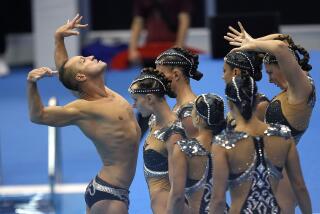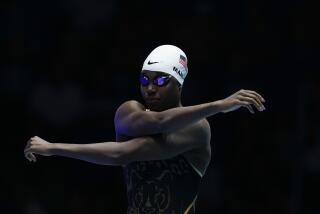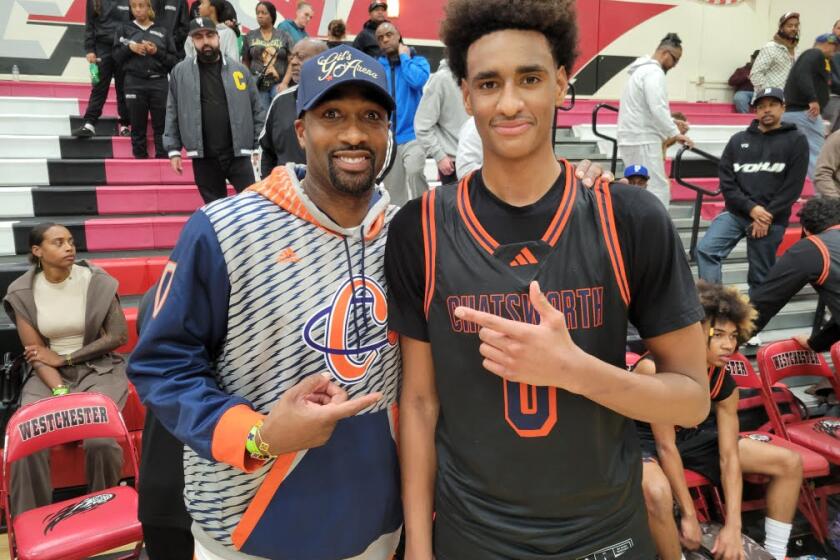Adults Have the Last Lap : * Masters programs give structured workouts with the guidance of a coach--the same benefits found in schools.
Gordon Cady Jr. cuts quite a figure as he paces around the pool at Irvine’s Heritage Park Aquatic Center.
In contrast to the Speedo-clad swimmers, Cady stomps about in knee-high rubber waders, with blues jeans and a plaid wool shirt. He’s the first to admit the outfit is not exactly fashion-forward, but Cady is thinking of his health first; trudging around in damp shoes and clothes during those chilly morning workouts is an easy ticket to pneumonia.
Cady is the head coach of Irvine Novaquatics, a private masters swimming program based at the Heritage pool complex. A coach with 23 years of experience, Cady leads the morning workouts while Tim Olyphant, an Olympic hopeful, leads the noon and evening sessions.
Masters swim programs, such as Novaquatics, allow adult swimmers some of the benefits accorded swimmers in high school and college programs: regular, structured workouts with the guidance of a professional coach.
Cady’s program has 95 swimmers, fully one-third of the membership of the Southern Pacific Masters Assn., which covers an area from Oxnard to San Clemente, and includes members in Nevada and Arizona. Novaquatics is the biggest program in the county, with a UC Irvine program running second.
The swimmers in Novaquatics range in age from 21 to about 65, Cady says, and include people who compete in ocean swims, pool meets and triathlons. Others “just want to work out to be in shape,” Cady says.
There are former high school and college swimmers who have rediscovered the sport after developing a “middle-age paunch,” Cady says. Then again, “some of the hardest workers I have . . . never swam in high school or college.”
Workouts in the program last 1 1/2 hours. Coaches handle the routines differently, but Cady opens with a warm-up of about 1,000 yards and moves into interval training (sets of 200 yards with brief rests, for instance). He concentrates on the freestyle Monday, Wednesday and Friday, and shifts to the “odd strokes”--butterfly, breast stroke, backstroke--on Tuesday and Thursday.
During a workout, more serious swimmers may top 5,000 yards while others may do 1,500 to 2,000. For any real benefit, Cady says swimmers need to do three workouts a week. Some may do as many as six a week.
Swimming, says Cady, is an excellent aerobic activity that works all the major muscle groups. It doesn’t put the stress on leg joints and back that running does (a few swimmers experience shoulder problems, but Cady says these are usually the result of improper technique or existing physical limitations).
Many people who swim for exercise swim laps on their own. Many of the people he sees swimming laps could benefit from a coach and a structured workout program, Cady says.
Improper technique, both movement and breathing, can make swimming much more difficult than it need be. Also, the endless, one-speed back-and-forth of most lap swimmers is a limited workout. Structured interval training, which intersperses brief rest periods during the workout, is a much better way to build speed and endurance.
Also, swimming laps can get a little dull.
“This is the most boring sport in the world, sticking your face in the water and following that little black line” on the pool bottom, Cady says. Swimming in a group, with a structured routine, can give a swimmer goals and boost speed through friendly rivalries.
Cady does not discourage beginners from joining the program. The first technique he works on is breathing. Learning to breathe properly is the first step to improving workouts--as Cady says, “you get tired really fast if you don’t know how to breathe.”
Next is a primer on what Cady calls “gross motor movements.” Many lap swimmers, even those who once swam competitively, expend too much energy through bad technique, simply moving their arms when they should be “moving water.”
“This is a ‘feel’ sport,” Cady says. “I spend a lot of time teaching people how to move water.”
The other points Cady emphasizes is holding on to proper technique even when fatigue sets in. Swimmers can expect to “die” when they hit their physical limit; the goal is to “die with finesse.”
Membership in Irvine Novaquatics is $35 a month ($15 for swimmers over 60), which covers all workouts. For information, call (714) 731-8686.
More to Read
Get our high school sports newsletter
Prep Rally is devoted to the SoCal high school sports experience, bringing you scores, stories and a behind-the-scenes look at what makes prep sports so popular.
You may occasionally receive promotional content from the Los Angeles Times.






